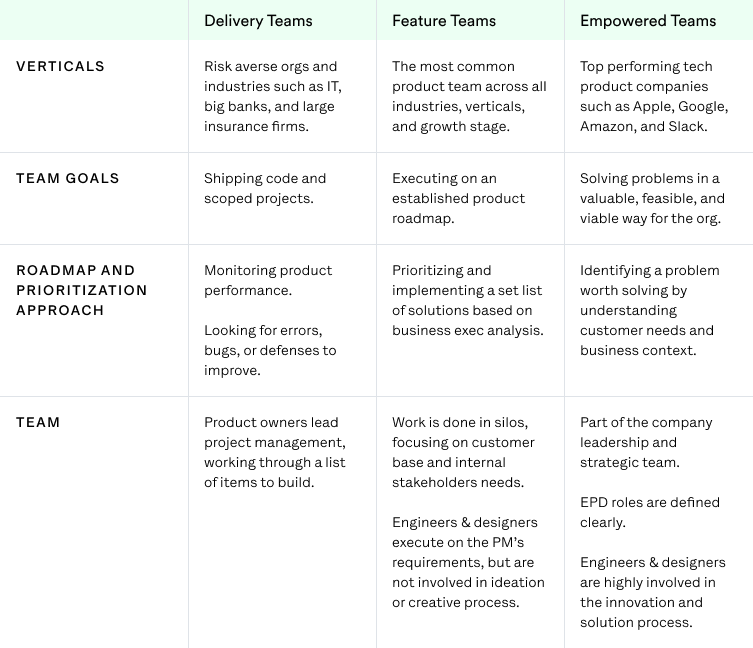Data-Transformed
Turn your feature team into a product powerhouse? Here are 4 ways to do it.
This article is inspired by a Product Salon featuring Rachel Obstler, Heap’s EVP of Product, and Marty Cagan of SVPG. In the session, Marty discussed his views on how the best product companies build and empower their product teams.
When it comes to product innovation, it's easy to think of three key players: the users who experience pain points, the leadership who sets the direction, and the product team who solves the problems. But not all product teams are created equal.
For many companies, product teams are simply feature teams–responsible for building what they're told to build. However, for companies like Apple, Google, and Amazon, an empowered product team is the driving force behind their innovation and success. These teams are given the freedom to determine the best solutions for their users and are enabled to find the right tools and approaches to get there.
In this blog post, we'll walk you through the critical differences between product teams and feature teams, and discuss the importance of empowering your product team for true business transformation and success. We'll also dive into some key best practices for building a powerful, empowered product team, including the benefits of an insights-driven product strategy.
The three types of product teams out there
Creating an empowered team requires strong leadership, coaching, and clear roles for the product manager, product designer, and tech lead. When these roles are defined and empowered, a team can deliver innovative solutions that meet both customer and business needs.
Marty defined 3 types of teams. Let’s take a look at them:

Which type of product team is best for me?
An interview with Steve Jobs called "The Lost Interview" offers some interesting insight into why so many companies rely on feature teams. As a company grows, it can become less focused on the product and more on driving growth.
Sales and marketing executives often drive this growth and are promoted to leadership positions. Unfortunately, these executives may not fully understand the nature of the product and its use cases, which can then lead to a lack of innovation and stagnation.
It's important to recognize that this isn't an either/or situation. While feature teams can be effective in certain situations (like optimization of known use cases and user flows), empowered product teams offer a more sustainable approach to product development and innovation. By prioritizing the product and empowering the right people, companies can build innovative products that meet both customer needs and business goals.
4 best practices for building an empowered product team
1. Build a culture of cross-functional continuous learning
Agile processes are important, but to truly transform your business, you need a culture of continuous learning and improvement. Everyone should be able to contribute to the product's success, embracing experimentation, risk-taking, and a willingness to learn from mistakes. This requires cross-functional collaboration and a focus on customer needs, market trends, and competitor analysis.
Read more about how to easily support continuous learning and build customer empathy:
2. Use insights to guide your product strategy
Data insights, qualitative learning, industry insights, and enabling technology are all crucial sources of insights. By leveraging analytics, product teams can gain valuable insights into user behavior, identify patterns, and make data-driven decisions. Even companies with feature teams must prioritize instrumentation to guide their product roadmap and make more informed decisions. This is a mandatory step for any product team.
Read more about recommended best practices to enhance this pillar of empowered team building:
3. Designate the commander in chief
It’s important to designate someone to take responsibility for the value and viability of your products. The person who typically takes on this role is the Product Manager, and they are responsible for ensuring that the product is not only valuable to customers, but also that it is viable for the business to produce and sell. It’s also important to encourage your product management to develop people skills, so product managers can deal with stakeholders at different levels.
4. Invest in strong leadership
Investing in strong leaders and empowered product teams is key to successful business transformation. Leaders should focus on people over process so teams are able to solve problems instead of just execute on solutions. Product management teams should take responsibility for value and viability, and analytics and instrumentation should guide informed decision-making.
–
When you empower your product team, you're giving them the ability to drive innovation and make a real difference in your organization. By allowing them the freedom to think outside the box and come up with solutions that truly meet the needs of your users, you'll see a dramatic improvement in your products and your bottom line.
So if you're ready to take your business to the next level, it's time to invest in your product team and give them the power to innovate and drive success.

